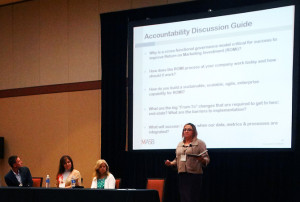MASB Summer Summit 2015

Transparency in metrics, processes and governance is essential for any business trying to improve return on marketing investment (ROMI), according to the Cross-Functional Roles in Accountability panel at MASB’s Summer Summit in August.
Pam Forbus, PepsiCo’s Senior Vice President of Global Consumer Demand Insights, led the discussion, “What will/does success look like when our metrics & processes are integrated?”
The panelists were Kristen Blum, CIO, PepsiCo; Tracey Joubert, CFO, MillerCoors; and Travis Colvin, head of Marketing Supply Chain for Kimberly-Clark North America.
Why is a cross-functional governance model critical for success to improve ROMI?
Joubert: “We found that the only way we could understand marketing investment and how we would get a return was to actually sit down at the table with marketing and understand what they were doing and what was driving them – and putting numbers to it. We created a role to help with this collaboration.”
Blum: “We have a lot of work to do in terms of how we govern projects, initiatives and efforts and how they affect one another. We won’t make intelligent choices if we keep a myopic viewpoint. Governance is required in this space to oversee how something in one area might impact things in other areas.”
Colvin: “Cross-functional collaboration extends well beyond the relationship of just marketing and finance. There are a lot of different individuals in the organization that need to come together to ensure that there’s one centralized governance process – all geared toward achieving the same outcome.”
How does the ROMI process at your company work today and how should it work?
Joubert: “Because of the impact the economy was having on our business, we thought that we needed to do something different. One of the things we looked at was the efficiency of our spend. It was astounding how much we were spending on non-working dollars. We started working with agencies, because that was an easy place to start. We figured out that we had several different brand managers that were all giving briefs to different ad agencies for the same brand.”
Forbus: “In our organization today, each business unit has its own resource allocation model and the effectiveness of those models vary widely. We don’t have to invent a new model, we simply have to find the pockets of excellence and more evenly distribute best practice across the enterprise.”
Blum: “Don’t underestimate the amount of work that needs to get done to understand the definitions of the metrics. You need complete transparency to understand their effectiveness.”
Colvin: “It’s surprising to me how little transparency there is as to where we’re investing. As you bring transparency forward, it gives you a platform to ask questions that can drive a behavior change in how you can optimize the mix of an investment.”
How do you build a sustainable, scalable, agile, enterprise capability for ROMI?
Colvin: “It starts with getting your data in one central place. Then you need individuals who mine data, who can transform the data into insights and then processes within the organization to take those insights and turn them into behavioral change. Figuring out when to line up recommendations to drive influences is also an important part of the process.”
Blum: “For us, it’s identifying the most critical metrics that are going to help grow the company. It starts with the awareness that it’s a multi-year journey. We’d like to see progress sooner, but this is a tough nut to crack. You have to prioritize those things that are really going to give you the biggest bang for your buck. For us, it started with aligning on master data around products, customers, vendors and locations. You have to get people on the same page. What you recognize every step of the way is that everything does impact everything else.”
